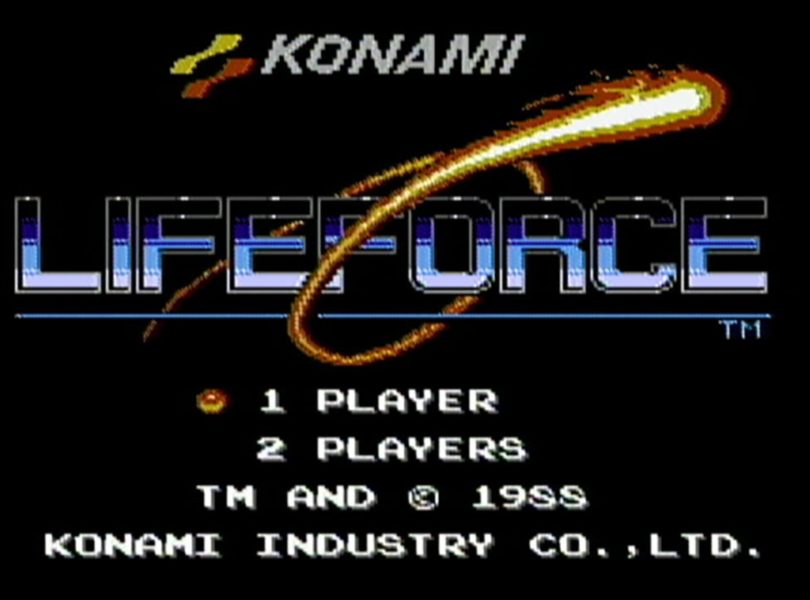30 Lives, Excessive Force
Release Date: August 1988
Developer: Konami
Publisher: Konami
There is a term I bring up whenever I hear someone raised on Xbox and PlayStation complain about the difficulty of a game nowadays. My daughter is one who has complained as such. My response to her is the same as it is to anyone who never played a game on a system older than the Nintendo 64.
There are three kinds of difficulty in video games: easy, hard, and NINTENDO HARD!
The latter difficulty is one known to many 8-bit aficionados. The NES is a known haven for games difficult enough to make the Dalai Lama curse like a drunk pirate with syphilis. Games like Battletoads, Ninja Gaiden, and Kid Icarus are spoken with disdain nowadays. Life Force, Konami’s awesome co-op shoot-‘em-up, falls squarely into this camp.
How difficult is it? Using the Konami Code here grants players 30 lives, just as in Contra. And just as in Contra, entering the code is a requirement if neophyte players wish to see anything past the second level.
Originally named Salamander in Japan and in the arcades, the North American title is a really fun and challenging shoot-‘em-up that’s considered an offshoot of Konami’s venerated Gradius series. Gamers in the States received this game instead of Gradius II, which was never formally released for the NES outside of Japan. While very similar to Gradius, Life Force featured co-op play and top-down levels as well as the standard side-scrolling fare, features not present in the original series.
The story for the game is pretty standard stuff. An alien creature called Zelos has developed an appetite for planets and tears through the universe doing his best Galactus impression. You are a pilot living in a planet that is in Zelos’s path, and you board your Vic Viper knockoff craft in an attempt to stop Zelos from munching on your home planet.
Your path to Zelos spans six stages that alternate between side-scrolling and top-down perspectives. All the usual trappings of SHMUPS (I hate that acronym but am getting lazy in my typing) are present here. Destroyed enemies often leave behind power-ups that augment your ship’s speed and armament. One hit destroys your ship, but unlike other games in the genre that restart you at the last checkpoint, you rematerialize exactly where you died. This gives you a chance to recover all the power-ups your ship shed when it came apart.
Six stages don’t seem to be a very large amount of area, and it isn’t. The stages are not overly long, so play time is theoretically short. I say theoretically because the sheer number of enemies and shots thrown at you during gameplay is almost criminal. Diehard Life Force veterans will be able to pick up the game’s rhythm and persevere. The rest of us will be furiously pounding in the Konami Code repeatedly after every defeat just to try and make it a smidge further.
In a departure from the mainline Gradius series, Life Force allows 2-player co-op. This lowers the odds considerably, as two powered-up ships are better able to fend off the alien hordes. Many areas in the game seem tailor made for co-op, as they have two paths that can be cleared easier with a wingman. The game is still punishing in co-op, but it’s more manageable.
Still, the game will do everything in its power to make you cry.
Technically, this game is awesome. The graphics are top-notch for the era in which it came out, and the soundtrack was typical Konami: excellent. Whatever the frustration factor may be for you, the game is proficient everywhere else.
Does it still hold up? For shoot-‘em-up fans, absolutely. Part of the fun in these games is the difficulty, and Life Force has it in spades. More casual players will get frustrated quickly, even with the Konami Code upping their chances. The game is unforgiving and can possible turn off players who like the genre but can’t handle the difficulty.
For those who want to give it a try, there are several ways to do so. The game was ported to numerous systems in the 80s, including the Commodore 64, TurboGrafx-16, MSX, Amstrad CPC, and ZX Spectrum. Recently, the game has seen a release on the PS4 as well as the Wii, Wii U, and 3DS Virtual Consoles. However you grab it, it is a quality title and another gem in Konami’s NES library.
It’d be a good idea to keep your blood pressure normal before you start to play, though. Nintendo hard games can make anyone lose it.
Good: Excellent gameplay; top-notch soundtrack; great visuals for the time
Bad: Unforgivingly difficult; relatively short
Final score: 7.5/10


